Decoupling Relationship between Resource Environment and High-Quality Economic Development in the Yellow River Basin
Abstract
1. Introduction
2. HQED Evaluation Index System
3. Methods and Data
3.1. Comprehensive Decoupling Index
3.2. Markov Chain Model
3.3. Two-Stage Entropy Method
3.4. Study Area and Data Sources
4. Results and Discussion
4.1. The HQED Level and Resource and Environmental Pressure in the YRB
4.2. Comprehensive Decoupling Analysis in the YRB
4.2.1. Spatial Distribution of City-Level Comprehensive Decoupling Status
4.2.2. The Evolution of City-Level Comprehensive Decoupling Status
5. Conclusions and Recommendations
5.1. Conclusions
5.2. Recommendations
6. Limitations of the Study
Author Contributions
Funding
Institutional Review Board Statement
Informed Consent Statement
Data Availability Statement
Conflicts of Interest
References
- Tomislav, K. The concept of sustainable development: From its beginning to the contemporary issues. Zagreb Int. Rev. Econ. Bus. 2018, 21, 67–94. [Google Scholar]
- Manioudis, M.; Meramveliotakis, G. Broad strokes towards a grand theory in the analysis of sustainable development: A return to the classical political economy. New Political Econ. 2022, 27, 866–878. [Google Scholar] [CrossRef]
- Gao, Y.; Xu, Z. Beyond drainage economics: The model and path for high-quality development of the real economy in the Yellow River Basin. Econ. Probl. 2020, 10, 1–9. [Google Scholar]
- Li, Q. A study on the spatial relationship of the urban carbon dioxide emission in the Yellow River Basin. J. Grad. Sch. Chin. Acad. Soc. Sci. 2021, 3, 71–79. [Google Scholar]
- Xu, H.; Wang, Y.; Zhang, Z.; Gao, Y.; Zhang, D. Coupling mechnaism of water-energy-food and spatiotemporal evolution of coordinated development in the Yellow River Basin. Resour. Sci. 2021, 43, 2526–2537. [Google Scholar]
- Wei, W.; Jin, C.; Han, Y.; Huang, Z.; Niu, T.; Li, J. The Coordinated development and regulation research on public health, ecological environment and economic development: Evidence from the Yellow River Basin of China. Int. J. Environ. Res. Public Health 2022, 19, 6927. [Google Scholar] [CrossRef]
- Lu, D.; Sun, D. Development and management tasks of the Yellow River Basin: A preliminary understanding and suggestion. Acta Geogr. Sin. 2019, 74, 2431–2436. [Google Scholar]
- Yao, S.; Liu, P.; Wei, H. Research on coupling coordinated development and its driving mechanism of agricultural ecological-economic system in the Yellow River Basin under the perspective of food security. Chin. J. Agric. Resour. Reg. Plan. 2023. Available online: https://kns.cnki.net/kcms/detail//11.3513.S.20230117.0909.004 (accessed on 7 June 2023).
- Li, X.; Xu, J.; Ren, X.; Li, L. Man-land relationship and development in the regions along Yellow River. Hum. Geogr. 2012, 27, 1–5. [Google Scholar]
- Liu, K.; Qiao, Y.; Shi, T.; Zhou, Q. Study on coupling coordination and spatiotemporal heterogeneity between economic development and ecological environment of cities along the Yellow River Basin. Environ. Sci. Pollut. Res. 2021, 28, 6898–6912. [Google Scholar] [CrossRef]
- Li, D.; Lin, L.; Lin, Z.; Zhang, S.; An, L. EKC test of ecological protection and high-quality development in the Yellow River Basin. Acta Ecol. Sin. 2021, 41, 3965–3974. [Google Scholar]
- Chen, S.; Zhang, H.; Qi, Y.; Liu, Y. Spatial spillover effect and influencing factors of haze pollution in the Yellow River Basin. Econ. Geogr. 2020, 40, 40–48. [Google Scholar]
- Sun, C.; Jin, C.; Hao, S. Study on water-energy-food nexus relationship of the Yellow River Basin. Yellow River 2020, 42, 101–106. [Google Scholar]
- Xu, R.; Liu, W. Relationship between agricultural grey water footprint and economic growth in the Yellow River. Chin. J. Agric. Resour. Reg. Plan. 2022. Available online: https://kns.cnki.net/kcms/detail//11.3513.S.20221207.1631.009.html (accessed on 7 June 2023).
- Sun, S.; Tang, Q. Spatiotemporal patterns and driving factors of water resources use in the Yellow River Basin. Resour. Sci. 2020, 42, 2261–2273. [Google Scholar] [CrossRef]
- Jiang, C.; Sheng, C.; Zhang, Y. Research on industrial transformation and upgrading and green development in the Yellow River Basin. Academics 2019, 11, 68–82. [Google Scholar]
- Liu, C.; Liu, X.; Tian, W.; Xie, J. Ecological protection and high-quality development of the Yellow River Basin urgently need to solve the water shortage problem. Yellow River 2020, 42, 6–9. [Google Scholar]
- Cai, Z. Increasing the utilization of sewage resources to promote the high-quality development of the Yellow River Basin. China Environ. News 2022. Available online: https://baijiahao.baidu.com/s?id=1736390704407310879&wfr=spider&for=pc (accessed on 7 June 2023).
- Xue, D.; Xu, G. Analysis of the path to build coordinated environmental governance in the Yellow River Basin. J. Henan Univ. Technol. Soc. Sci. 2022, 38, 48–56. [Google Scholar]
- Ministry of Ecology and Environment. National Air Quality Status; Ministry of Ecology and Environment: Beijing, china, 2023.
- Zhou, Q.; He, A. Can environmental regulation promote the high-quality development of the Yellow River Basin. Financ. Econ. 2020, 6, 89–104. [Google Scholar]
- Ren, B.; Du, Y. Coupling coordination of economic growth, industrial development and ecology in the Yellow River Basin. China Popul. Resour. Environ. 2021, 31, 119–129. [Google Scholar]
- Li, R.; Liu, T. Analysis of the decoupling relationship between ecological footprint and economic growth of cities along the Yellow River Basin and influencing factors. J. Guizhou Univ. Financ. Econ. 2021, 39, 103–111. [Google Scholar]
- Liu, H.; Shao, M.; Sun, D. The practical and major achievements of China’s green development in the new era: Based on the coordination of resource, environment and economy. Inq. Econ. Issues 2022, 9, 133–147. [Google Scholar]
- Baloch, M.A.; Mahmood, N.; Zhang, J.W. Effect of natural resources, renewable energy and economic development on CO2 emissions in BRICS countries. Sci. Total Environ. 2019, 678, 632–638. [Google Scholar]
- Dogan, E.; Inglesi-Lotz, R. The impact of economic structure to the environmental Kuznets curve (EKC) hypothesis: Evidence from European countries. Environ. Sci. Pollut. Res. 2020, 27, 12717–12724. [Google Scholar] [CrossRef] [PubMed]
- Sarkodie, S.A.; Strezov, V. Effect of foreign direct investments, economic development and energy consumption on greenhouse gas emissions in developing countries. Sci. Total Environ. 2019, 646, 862–871. [Google Scholar] [CrossRef] [PubMed]
- Zhang, Z. Decoupling China’s carbon emissions increase from economic growth: An economic analysis and policy implications. World Dev. 2000, 28, 739–752. [Google Scholar] [CrossRef]
- Camara, M. Determinants of production-based and consumption-based CO2 emissions: A comparative analysis. Int. J. Environ. Pollut. 2020, 67, 22–47. [Google Scholar] [CrossRef]
- De Freitas, L.C.; Kaneko, S. Decomposing the decoupling of CO2 emissions and economic growth in Brazil. Ecol. Econ. 2011, 70, 1459–1469. [Google Scholar] [CrossRef]
- Song, Y.; Sun, J.; Zhang, M.; Su, B. Using the Tapio-Z decoupling model to evaluate the decoupling status of China’s CO2 emissions at provincial level and its dynamic trend. Struct. Change Econ. Dyn. 2020, 52, 120–129. [Google Scholar] [CrossRef]
- Li, L.; Shan, Y.; Lei, Y.; Wu, S.; Yu, X.; Lin, X.; Chen, Y. Decoupling of economic growth and emissions in China’s cities: A case study of the Central Plains urban agglomeration. Appl. Energy 2019, 244, 36–45. [Google Scholar] [CrossRef]
- Dong, F.; Li, J.; Zhang, X.; Zhu, J. Decoupling relationship between haze pollution and economic growth: A new decoupling index. Ecol. Indic. 2021, 129, 107859. [Google Scholar] [CrossRef]
- Zhang, H.; Huang, Y.; Wang, R.; Zhang, J.; Peng, J. Decoupling and spatiotemporal change of carbon emissions at the county level in China. Resour. Sci. 2022, 44, 744–755. [Google Scholar] [CrossRef]
- Wang, X.; Xu, Z.; Li, Y. A rough estimate of water footprint of Gansu Province in 2003. J. Nat. Resour. 2005, 20, 909–915. [Google Scholar]
- OECD. Indicators to Measure Decoupling of Environmental Pressure from Economic Growth; OECD: Paris, France, 2002. [Google Scholar]
- Wang, L. Study on the interaction effect between economic growth and eco-environment in tianjin by dematerialization analysis. Reform. Strategy 2012, 28, 143–146. [Google Scholar]
- Grand, M.C. Carbon emission targets and decoupling indicators. Ecol. Indic. 2016, 67, 649–656. [Google Scholar] [CrossRef]
- Li, K.; Zhou, Y.; Xiao, H.; Li, Z.; Shan, Y. Decoupling of economic growth from CO2 emissions in Yangtze River economic belt cities. Sci. Total Environ. 2021, 775, 145927. [Google Scholar] [CrossRef]
- Tapio, P. Towards a theory of decoupling: Degrees of decoupling in the EU and the case of road traffic in Finland between 1970 and 2001. Transp. Policy 2005, 12, 137–151. [Google Scholar] [CrossRef]
- Cohen, G.; Jalles, J.T.; Loungani, P.; Marto, R.; Wang, G. Decoupling of emissions and GDP: Evidence from aggregate and provincial Chinese data. Energy Econ. 2019, 77, 105–118. [Google Scholar] [CrossRef]
- Mikayilov, J.I.; Hasanov, F.J.; Galeotti, M. Decoupling of CO2 emissions and GDP: A time-varying cointegration approach. Ecol. Indic. 2018, 95, 615–628. [Google Scholar] [CrossRef]
- Li, Y.; Zhang, Y.; Yang, L.; Du, F.; Sai, L.; Zhang, B. Decoupling analysis of China’s mining industrial development and water usage: Based on production-based and consumption-based perspectives. J. Clean. Prod. 2023, 385, 135668. [Google Scholar] [CrossRef]
- Raza, M.Y.; Wu, R.; Lin, B. A decoupling process of Pakistan’s agriculture sector: Insights from energy and economic perspectives. Energy 2023, 263, 125658. [Google Scholar] [CrossRef]
- Xie, P.; Gong, N.; Sun, F.; Li, P.; Pan, X. What factors contribute to the extent of decoupling economic growth and energy carbon emissions in China? Energy Policy 2023, 173, 113416. [Google Scholar] [CrossRef]
- Wang, Q.; Zhang, F. The effects of trade openness on decoupling carbon emissions from economic growth–evidence from 182 countries. J. Clean. Prod. 2021, 279, 123838. [Google Scholar] [CrossRef]
- Gao, M.; Lu, Q. Decoupling relationship between water resources utilization and economic development in Yellow River Basin. Environ. Sci. Technol. 2021, 44, 198–206. [Google Scholar]
- Li, R.; Bai, Y.; Zhou, Y.; Huang, S.; Yan, Z.; Li, Y.; Zhao, H. Decoupling and decomposition of driving factors of water resources utilization and economic growth in the Yellow River Basin. Sci. Geogr. Sin. 2023, 43, 110–118. [Google Scholar]
- Zuo, Q.; Zhang, Z.; Ma, J. Relationship between water resource utilization level and socio-economic development in the Yellow River Basin. China Popul. Resour. Environ. 2021, 31, 29–38. [Google Scholar]
- Zhang, Y.; Yu, Z.; Zhang, J. Spatiotemporal evolution characteristics and dynamic efficiency decomposition of carbon emission efficiency in the Yellow River Basin. PLoS ONE 2022, 17, e0264274. [Google Scholar] [CrossRef]
- Zhang, H.; Yuan, P.; Zhu, Z. Decoupling effects of carbon emissions and reduction path in the Yellow River Basin. Resour. Sci. 2022, 44, 59–69. [Google Scholar] [CrossRef]
- Zhong, Z.; Chen, Z. Business environment, technological innovation and government intervention: Influences on high-quality economic development. Manag. Decis. 2023. ahead of print. [Google Scholar] [CrossRef]
- Wang, J.; Che, S. The impact of digital economy on high-quality development in the Yellow River Basin: Empirical evidence from urban heterogeneity. Resour. Sci. 2022, 44, 780–795. [Google Scholar] [CrossRef]
- Sun, C.; Tong, Y.; Zou, W. The evolution and a temporal-spatial difference analysis of green development in China. Sustain. Cities Soc. 2018, 41, 52–61. [Google Scholar] [CrossRef]
- Wang, B.; Yan, L. Decoupling effects of water footprint and high-quality economic development in Yangtze River economic belt. J. Econ. Water Resour. 2022, 40, 6–12. [Google Scholar]
- Tian, Q. Theoretical connotation and practical requirements for high-quality development. J. Shandong Univ. Philos. Soc. Sci. 2018, 6, 1–8. [Google Scholar]
- Li, J.; Shi, L.; Xu, A. Probe into the assessment indicator system on high-quality development. Stat. Res. 2019, 36, 4–14. [Google Scholar]
- Liu, L.; Liang, L.; Gao, P.; Fan, C.; Wang, H.; Wang, H. Coupling relationship and interactive response between ecological protection and high-quality development in the Yellow River Basin. J. Nat. Resour. 2021, 36, 176–195. [Google Scholar] [CrossRef]
- Ren, B.; Fu, Y.; Yang, Y. Measurement and improvement path of high quality development level in Yellow River Basin. J. Stat. Inf. 2022, 37, 89–99. [Google Scholar]
- Lv, D.; Wang, J.; Cheng, Z. Spatio temporal coupling and driving factors of digital economy, ecological protection and high-quality development in the Yellow River Basin. Inq. Econ. Issues 2022, 15, 135–148. [Google Scholar]
- Zhang, Z.; Xu, J.; Gao, Q.; Liu, W. Analysis on the difference of economic high-quality development level in the Yellow River Basin. Sci. Manag. Res. 2022, 40, 100–109. [Google Scholar]
- Sun, H.; Gui, H.; Yang, D. Measurement and evaluation of the high-quality of China provincial economic development. Zhejiang Soc. Sci 2020, 8, 4–14. [Google Scholar]
- Zhan, X.; Cui, P. Estimation and evaluation of China’s provincial quality of economic growth—Empirical analysis based on “five development concepts”. Public Financ. Res. 2016, 8, 42–54. [Google Scholar]
- Yu, Y.; Hu, S. The connotation, predicament and basic path of China’s economy of high-quality development: A literature review. J. Macro-Qual. Res. 2018, 6, 1–17. [Google Scholar]
- Sun, J.; Cui, Y.; Zhang, H. Spatio-temporal pattern and mechanism analysis of coupling between ecological protection and ecomomic development of urban agglomerations in the Yellow River Basin. J. Nat. Resour. 2022, 37, 1673–1690. [Google Scholar] [CrossRef]
- Ren, B. Theoretical interpretation and practical orientation of China’s Economy from high speed growth to high quality development in new era. Acad. Mon. 2018, 50, 66–74. [Google Scholar]
- Wang, L. The poverty theory of marxist political economy and its exploration and development in China. Shanghai J. Econ. 2018, 9, 31–34. [Google Scholar]
- Chen, Z.; Zheng, J. Can green technology innovation promote high-quality regional economic development? Mod. Econ. Sci. 2022, 44, 43–58. [Google Scholar]
- Hong, S.; Guo, Q.; Li, D. Spatiotemporal dynamics of ecological supply and demand based on ecological footprint theory. Resour. Sci. 2020, 42, 980–990. [Google Scholar] [CrossRef]
- Yu, F.; Fang, L. Issues regarding the ecological protection and high-quality development of Yellow River Basin. China Soft Sci. 2020, 6, 85–95. [Google Scholar]
- Jiang, L.; Zuo, Q.; Ma, J.; Zhang, Z. Evaluation and prediction of the level of high-quality development: A case study of the Yellow River Basin, China. Ecol. Indic. 2021, 129, 107994. [Google Scholar] [CrossRef]
- Liu, Y.; Feng, C. What drives the decoupling between economic growth and energy-related CO2 emissions in China’s agricultural sector? Environ. Sci. Pollut. Res. 2021, 28, 44165–44182. [Google Scholar] [CrossRef]
- Luo, H.; Li, L.; Lei, Y.; Wu, S.; Yan, D.; Fu, X.; Luo, X.; Wu, L. Decoupling analysis between economic growth and resources environment in Central Plains Urban Agglomeration. Sci. Total Environ. 2021, 752, 142284. [Google Scholar] [CrossRef]
- He, Y.; Cai, M. Decoupling relationship between economic growth and resource environment in Beijing-Tianjin-Hebei Region. J. Beijing Inst. Technol. Soc. Sci. Ed. 2016, 18, 33–41. [Google Scholar]
- Frodyma, K.; Papież, M.; Śmiech, S. Decoupling economic growth from fossil fuel use—Evidence from 141 countries in the 25-year perspective. Energies 2020, 13, 6671. [Google Scholar] [CrossRef]
- Liu, H.; Qiao, L.; Sun, S. Spatial distribution and dynamic change of water use efficiency in the Yellow River Basin. Resour. Sci. 2020, 42, 57–68. [Google Scholar] [CrossRef]
- Shi, B.; He, L.; Zhang, W. Dynamic evolution and trend prediction of high-quality urban economic development in the Yellow River Basin. Econ. Probl. 2021, 1, 1–8. [Google Scholar]
- Hu, S.; Jiao, S.; Zhang, X. Spatio-temporal evolution and influencing factors of China’s tourism development: Based on the non-static spatial Markov chain model. J. Nat. Resour. 2021, 36, 854–865. [Google Scholar] [CrossRef]
- Cui, R.; Li, G. Regional differences and distributional dynamics of internet level in China: 2006–2018. J. Quant. Tech. Econ. 2021, 38, 3–20. [Google Scholar]
- Chen, Z.; Chen, J.; Du, J. Study on coupling coordination development between logistics industry and national economy in China. China Bus. Mark. 2020, 34, 9–20. [Google Scholar]
- Huang, D.; Lin, X.; He, Z. Research on the decoupling relationship between high-quality economic development and water resources consumption in the Yellow River Basin. Rev. Econ. Manag. 2022, 38, 25–37. [Google Scholar] [CrossRef]
- Guo, F.; Tong, L.; Qiu, F.; Li, Y. Spatio-temporal differentiation characteristics and influencing factors of green development in the eco-economic corridor of the Yellow River Basin. Acta Geogr. Sin. 2021, 76, 726–739. [Google Scholar]
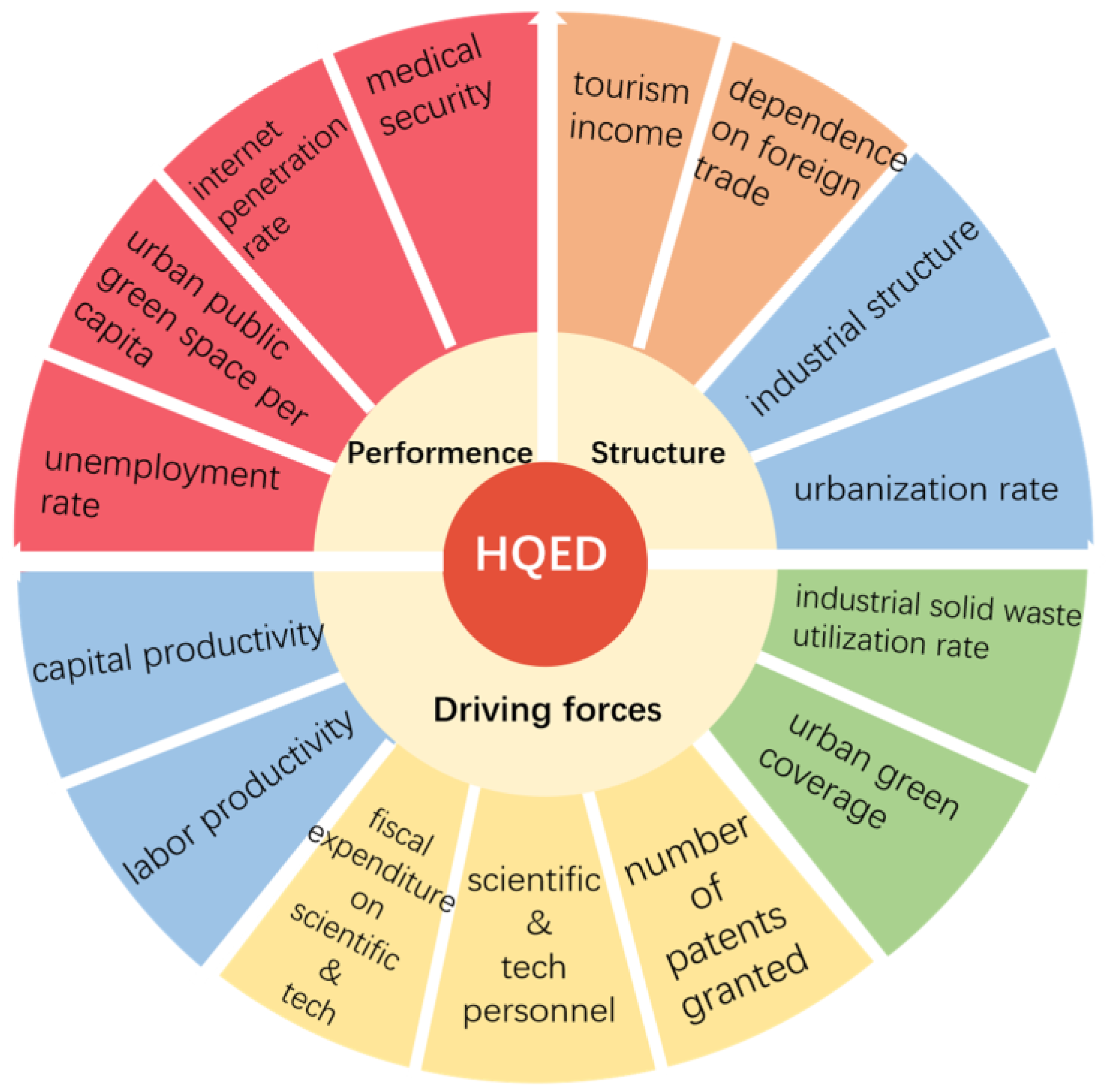
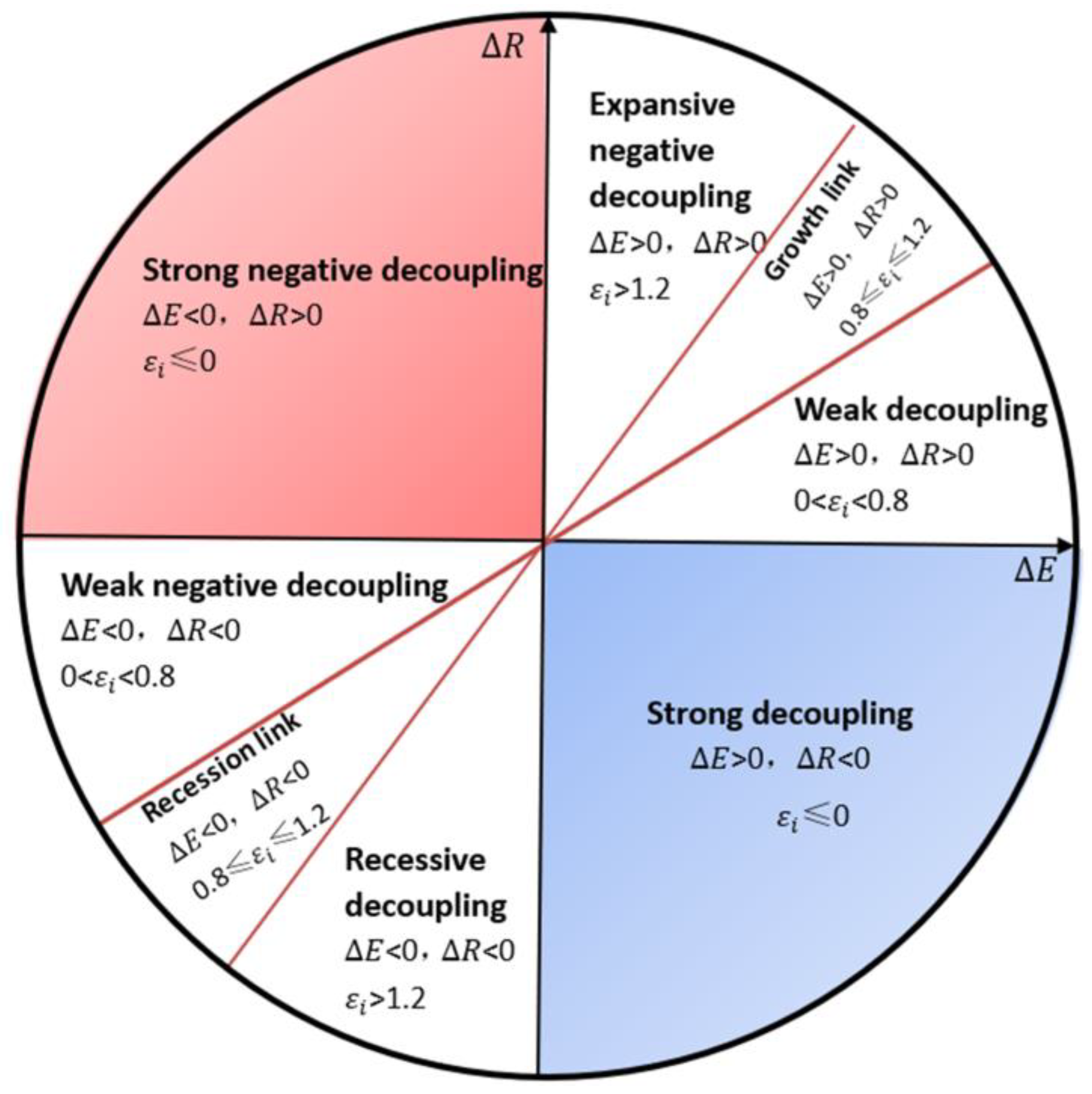
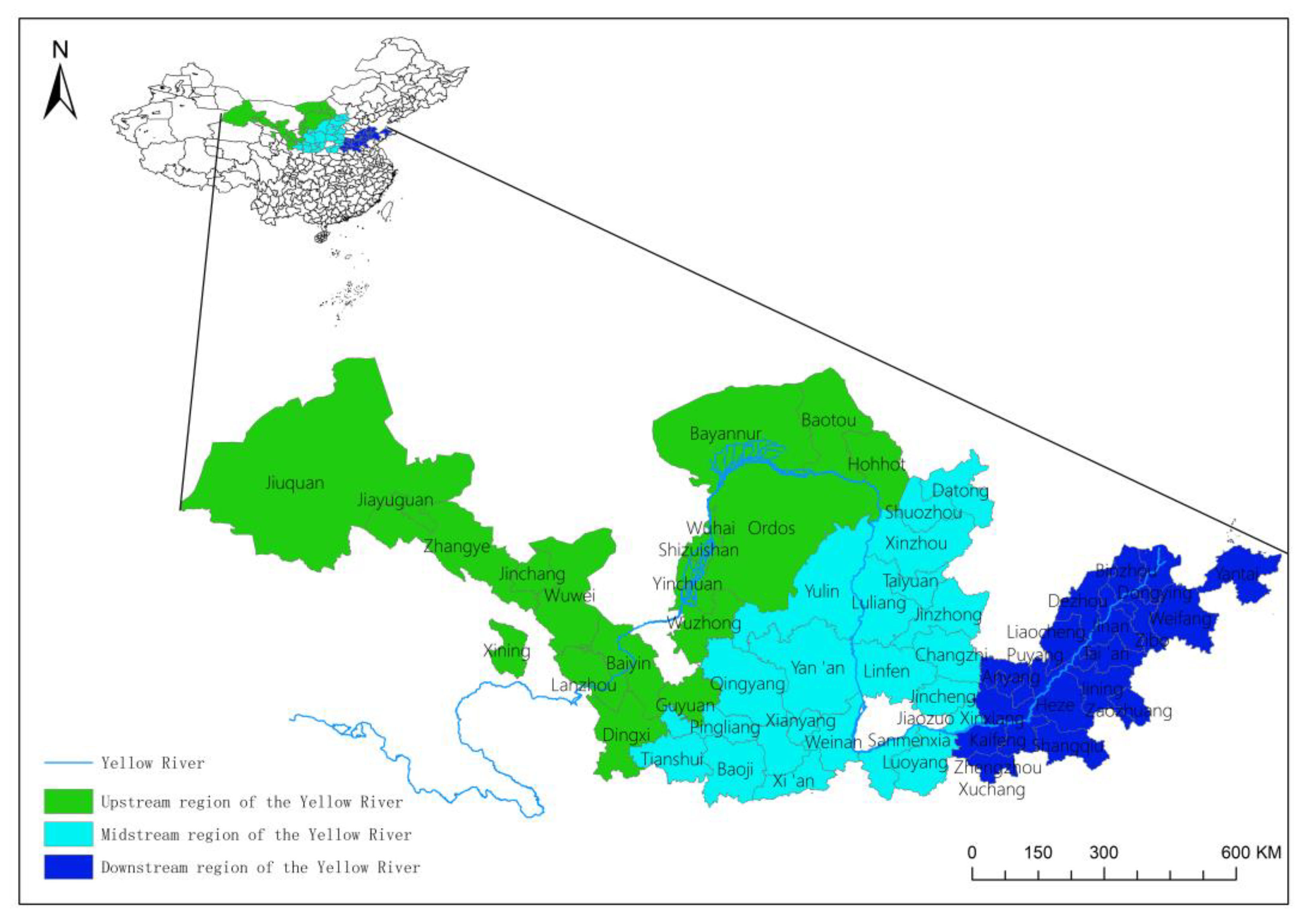
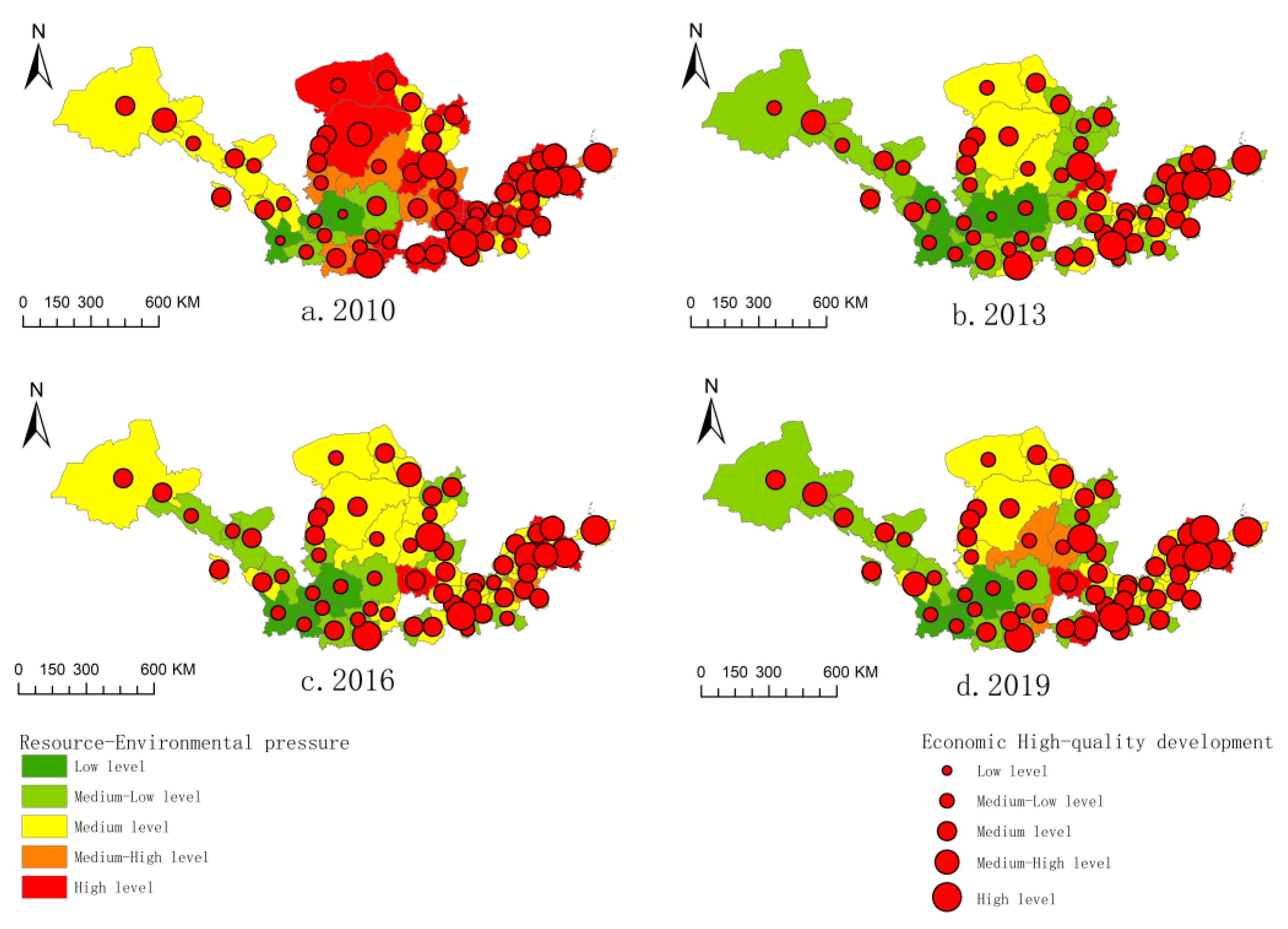
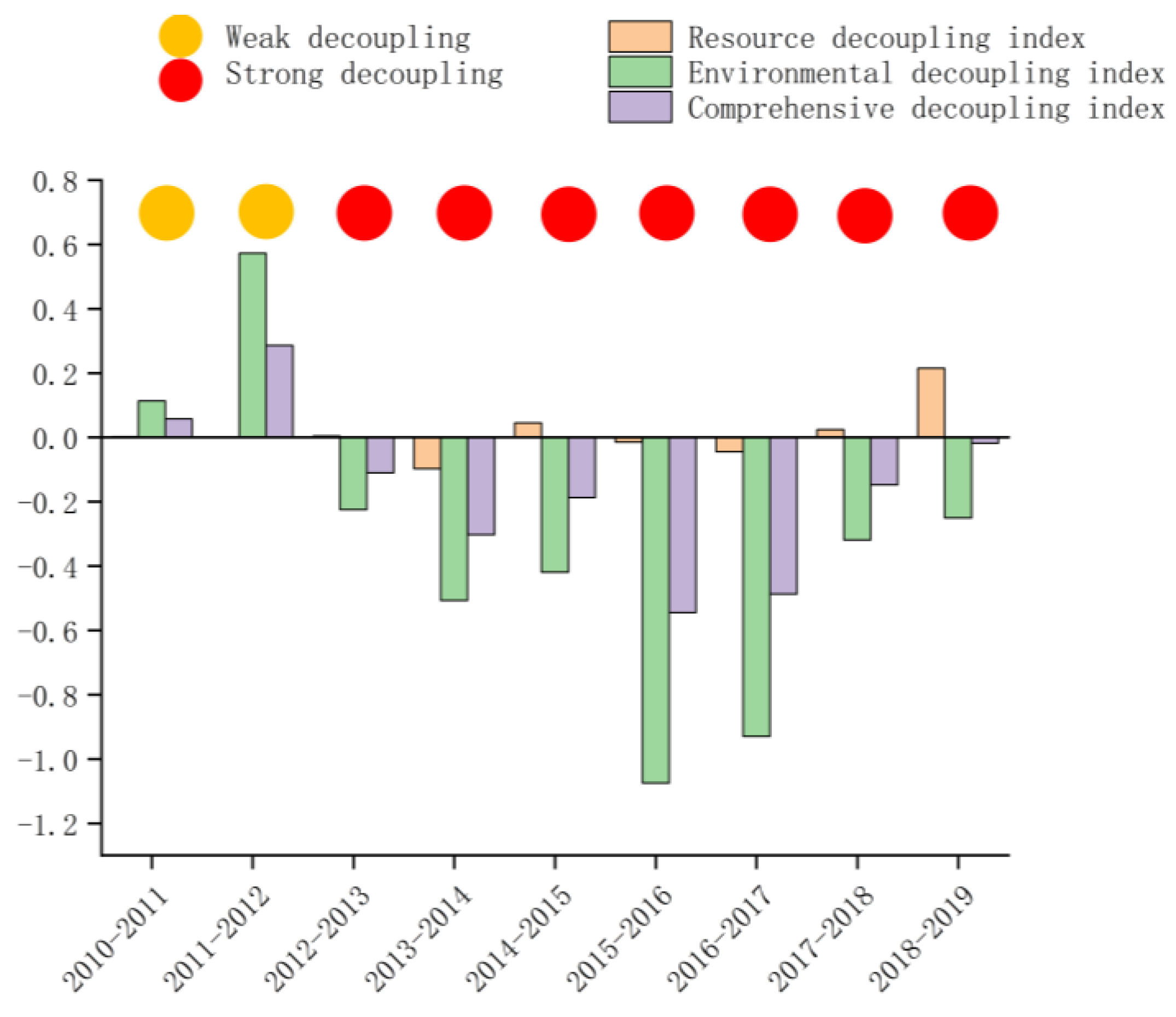
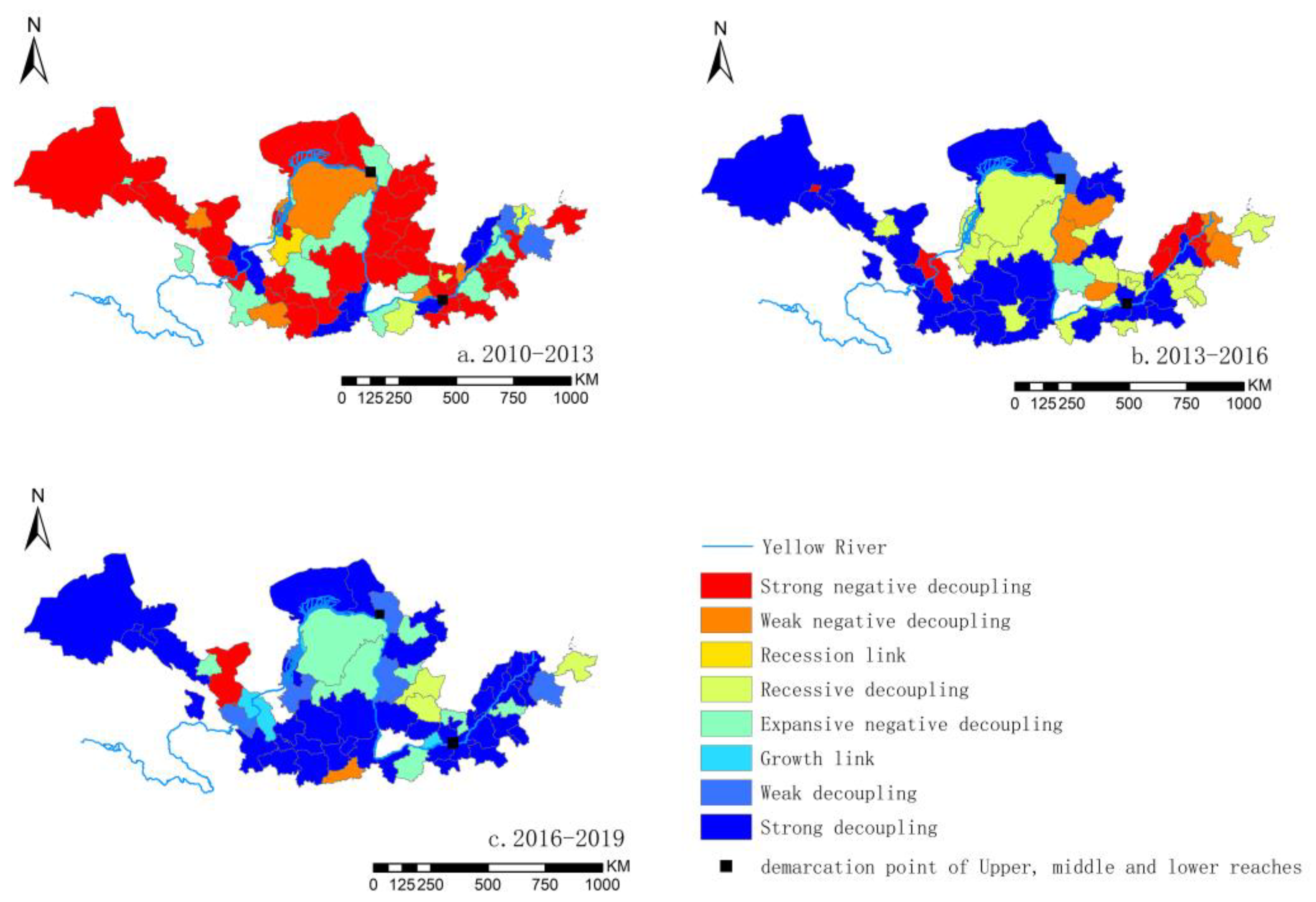
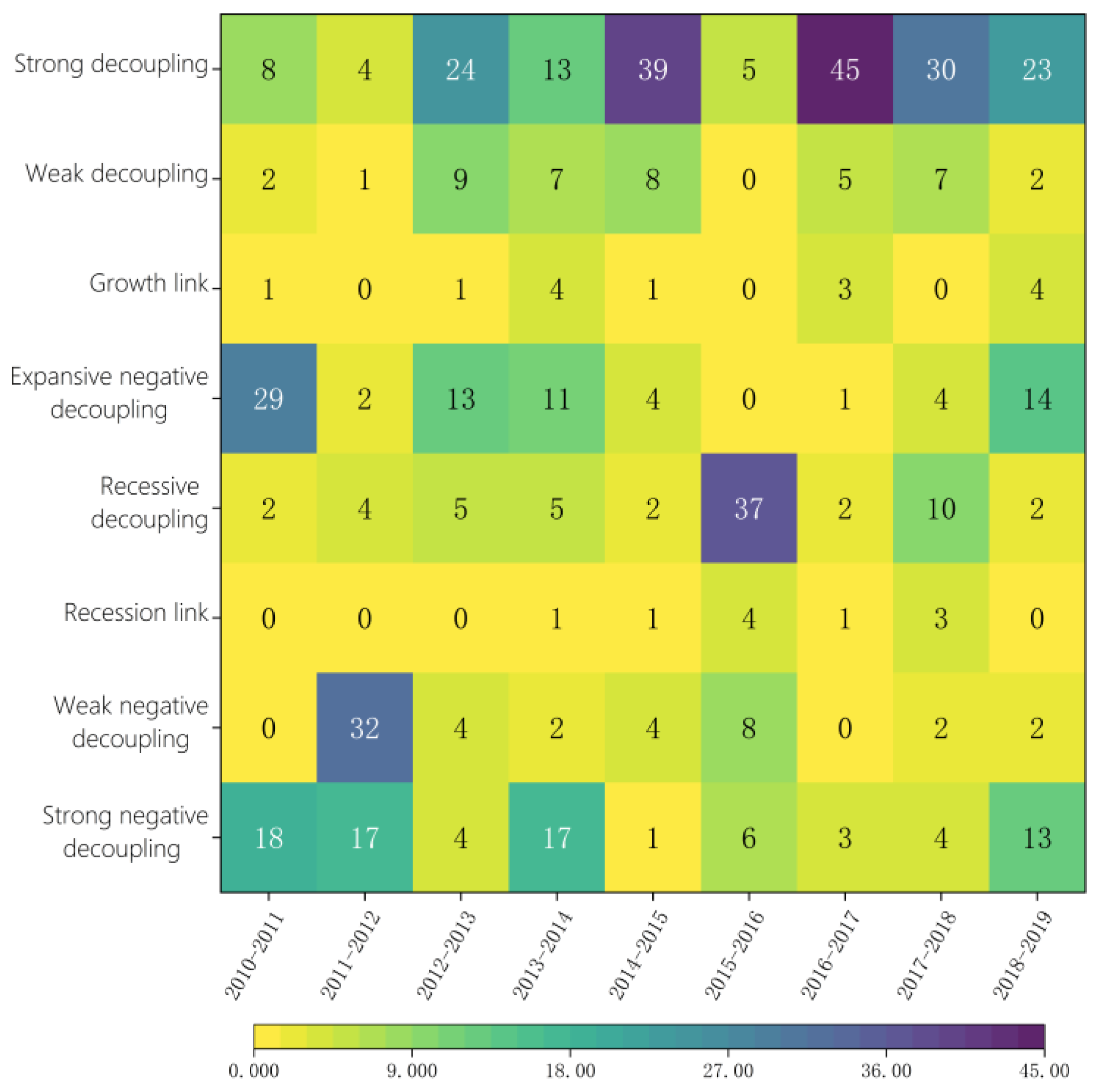

Disclaimer/Publisher’s Note: The statements, opinions and data contained in all publications are solely those of the individual author(s) and contributor(s) and not of MDPI and/or the editor(s). MDPI and/or the editor(s) disclaim responsibility for any injury to people or property resulting from any ideas, methods, instructions or products referred to in the content. |
© 2023 by the authors. Licensee MDPI, Basel, Switzerland. This article is an open access article distributed under the terms and conditions of the Creative Commons Attribution (CC BY) license (https://creativecommons.org/licenses/by/4.0/).
Share and Cite
Zhao, X.; Li, X.; Deng, G.; Xi, Y. Decoupling Relationship between Resource Environment and High-Quality Economic Development in the Yellow River Basin. Sustainability 2023, 15, 9385. https://doi.org/10.3390/su15129385
Zhao X, Li X, Deng G, Xi Y. Decoupling Relationship between Resource Environment and High-Quality Economic Development in the Yellow River Basin. Sustainability. 2023; 15(12):9385. https://doi.org/10.3390/su15129385
Chicago/Turabian StyleZhao, Xiaojing, Xuke Li, Guoqu Deng, and Yanling Xi. 2023. "Decoupling Relationship between Resource Environment and High-Quality Economic Development in the Yellow River Basin" Sustainability 15, no. 12: 9385. https://doi.org/10.3390/su15129385
APA StyleZhao, X., Li, X., Deng, G., & Xi, Y. (2023). Decoupling Relationship between Resource Environment and High-Quality Economic Development in the Yellow River Basin. Sustainability, 15(12), 9385. https://doi.org/10.3390/su15129385





